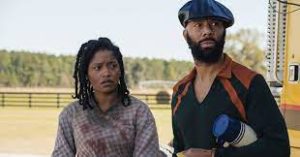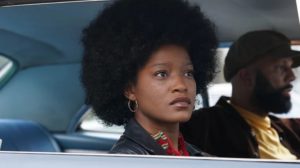Is Netflix’s 'Single All The Way' the “Answer” to Hulu’s 'Happiest Season'?
In the LGBTQ+ holiday rom-com wars, 'Single All The Way' may or may not be the “answer” to 'Happiest Season.'


In 1804, George Nichols, my father’s third great-grandfather, and his older sister were kidnapped from Africa. Though we don’t know the specific country, they were likely Cameroonian based on DNA research. George, 10 years old, was separated from his sister (never to see her again) and sold to someone who moved him to Washington, Georgia. He remained there until he died in 1921 (yes, he was 116 years old).

Having a known connection to enslaved Black people (who just happen to be my ancestors), I carefully discern which slave narratives I watch for entertainment purposes. But I was intrigued by Writer-Director Krystin Ver Linden’s concept and origin story for Alice. In an interview, Ver Linden mentioned being inspired by true stories of Black people still enslaved in the 1960s. That this was a century after the Emancipation Proclamation and even after the late release of Texans two years later in 1865 on June 19 (Juneteenth) blew my mind. So, I lined up (virtually) to watch Alice, which premiered during the Sundance Film Festival.
And…I was, quite frankly, left silent.
I was just not sure what I watched, how to feel about it, and how to write about what I felt about it, you know? I was experiencing dissonance and knew I’d need to watch it again to detach my emotional self from the story.
And, I did…
Alice is what I can only describe as a genre trifecta of sorts: one part revenge drama, one part historical account (loosely), and one part throwback to Blaxploitation—kinda Django Unchained meets Roots meets Foxy Brown, I think. And it definitely meets the Incluvie standards with the superb Keke Palmer starring as the titular character, Alice, who manages the emotional range to transition from being enslaved to freed and free. Palmer was the film’s North Star, lending credibility to some of the film’s inexplicable plot points.
It’s 1973. We time-travel backward to a plantation in Georgia where Black people work the field and serve petit fours and mint juleps to their White owners…still. Both stuck in a time warp on a plantation: one by choice, the other being held hostage, not knowing that there was a whole world (and a freeway) just beyond the moss-covered trees.
After Alice secretly marries Joseph (Gaius Charles), the film is set in motion. The plantation owner, Paul Bennett (Jonny Lee Miller), who obviously doesn’t believe in a woman’s right to choose, could fit any era from the 19th century to 2022. He not only holds Alice as property but as his own private property. Bennett suspects Alice is betrothed and lets Joseph know he’ll disappear him to be fruitful and multiply elsewhere. Another commonality to my own family tree is that my ancestor George was used in this same way for 40 years. After he was finally freed, he married my father’s third great-grandmother Medanne in his 50’s. Based on the sheer number of children he had throughout his life and their offspring, I could literally be related to Alice myself; but I digress.
After a few failed attempts to escape, Alice is taken down and muzzled by Bennett. This scene could’ve been one out of the real-time documentary Pushout. It parallels 21st Century trauma experienced by Black girls at high schools in Columbia, SC, pool parties in McKinney, Texas, or any other location somewhere in America. This is the altercation that ultimately gives Alice the strength to escape.
In the second act, Alice discovers that just beyond the trees is a paved highway–where she is almost pulverized by a big yellow MAC truck driven by Frank (Common). I don’t mean no harm (as we say where I’m from); I LOVE Just Wright, it’s one of my favorite films, but I’ve had a reimagining of almost anybody but Common in the role of Frank. Frank is pivotal to the story’s arc, and he comes off as a one-note, monotone-voiced dude whose catchphrase is “Be cool.” However, it’s not cool; it becomes hard to suspend disbelief at times.

Here are some examples:
When Frank picks up Alice (after almost flattening her on the highway), she is soiled and bloody, not having benefited from indoor plumbing recently or perhaps ever. But when they drive off, he begins singing along with the radio looking at the obviously bewildered Alice as if waiting for her to join in this impromptu karaoke moment. Nope.
Even after she upchucks all over the small cab, he keeps his cool; he’s just way too cool. We’re to believe Frank picks up a soiled and bloody woman who is, let’s be honest, very likely malodorous. He doesn’t offer a throwaway line, a window-roll-down, or a raised eyebrow? This small but large detail would’ve helped give Frank additional layers.
Shortly after that (as in the next day), Alice explores Frank’s house tasting her first baloney sandwich; and Frank neglects frying the baloney, its pièce de résistance. Alice happens upon articles about slavery and the Emancipation Proclamation–too on the nose. Palmer’s performance is equal to someone finding out they’ve been enslaved in a mostly free world. But it’s the pace of her discoveries: how a TV works, how to hunt down Bennett’s former wife, and how to zip and unzip jeans all happen in 24-hours; that seems implausible.

There is an oasis as the film approaches the end of the 2nd act. Ver Linden gifts us a music-filled montage with Stevie Wonder, Diana Ross, and a gospel song called Nobody Knows that I immediately downloaded. She added video clips of Malcolm X, Angela Davis, and Fred Hampton in the backdrop, Black and White photos, old school 33’s, Jet, Ebony, and Rolling Stone Magazines, and remnants of Frank’s time with the Black Panthers.
But reality strikes when Alice realizes the devastating truth: she’s been enslaved in a free world, and we shift into the film’s final act: Coffy meets Django Unchained. After discovering Diana Ross, Pam Grier, and Angela Davis, Alice cuts her hair into an Afro, dons Frank’s mom’s clothes, and becomes Foxy Brown or Coffy. Though Alice has an inner strength, this dramatic transformation seems a stretch in what appears to be a 24-hour timeframe. Especially when she decides to confront Bennett’s wife, who, for yet another inexplicable reason, agrees to meet her after being surprised that Alice was “out” (of the plantation, I guess?)

…and this is probably where I should’ve gotten out myself, but I was too close to the end, which I won’t spoil for you. I’ll just say there was some satisfaction, yet not enough to make me still not ask myself, “What just happened?” and “Why?” and also “Go Alice, Go!”

Related lists created by the same author
In the LGBTQ+ holiday rom-com wars, 'Single All The Way' may or may not be the “answer” to 'Happiest Season.'
Related movie/TV/List/Topic
James Cameron’s “Aliens” (1986) is a pinnacle of science fiction storytelling. Within this classic monster movie lies a powerful female character, Ellen Ripley (brilliantly portrayed by Sigourney Weaver).